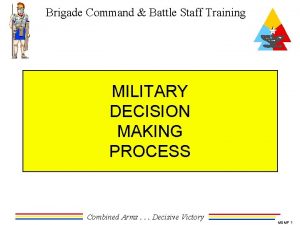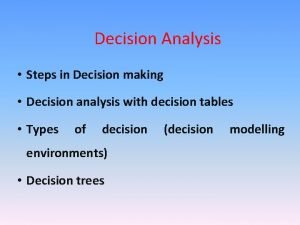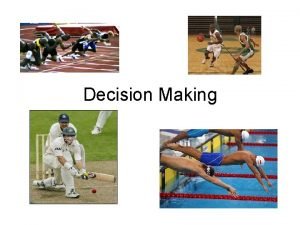DataDriven Decision Making Last Updated 031418 DataDriven DecisionMaking























- Slides: 23

Data-Driven Decision. Making Last Updated: 03/14/18

Data-Driven Decision-Making 2

Objectives: • Name the types of data that are used in child welfare to monitor outcomes. • Identify the ways that data can be used during the supervision process to improve outcomes. Data-Driven Decision-Making 3

on Management Thinking outside of the box vati Inno Attention to Available Data Success Optimized Management Data-Driven Decision-Making 4

Data is a collection of facts used as a basis for reasoning, discussion, or calculation. Data should do three things: 1. Confirm or disprove what you were already thinking. 2. Make you ask more of the right questions. 3. Cause you to act on what you discover. There are two types of data: 1. Qualitative 2. Quantitative Data-Driven Decision-Making 5

Data Warehouse: Infoview Examples of Reports: • Book of Business (BOB) • Dashboard Data-Driven Decision-Making 6

What we know about Data: • Data Warehouse is sensitive. • Messaging about use is key. • Regular access improves understanding. • Data entry errors may be a common pitfall. Data-Driven Decision-Making 7

Monthly Management Report (MMR) • It allows you time to get credit for work that has been done. • Second line managers and above may utilize this to identify trends. Data-Driven Decision-Making 8

Caseload Reports • Weekly unofficial pulls: – Goal of weekly sheets is to look at all cases and make sure they are properly assigned. – Improper assignment of cases can result in inaccurate data. • Every other month official pull for ISEP Data-Driven Decision-Making 9

Data • For a worker to get credit for what they do, it has to be entered into Mi. SACWIS correctly! • Get your workers in the habit of owning their data. • Timely accurate data entry matters! Data-Driven Decision-Making 10

Excel Spreadsheets • Many supervisors create their own spreadsheets to track their workers’ data. • Talk to other supervisors and learn their tracking styles. • This can help you with assessing and supervising your staff. Data-Driven Decision-Making 11

Data-Driven Decision-Making 12

Story Time A child comes into care in County A: • 50% chance of her being placed with her sibling… • 15% change of being returned home under 1 year… • 25% chance of having her medical needs attended to… • 70% chance of having her worker see her 2 x a month… • 25% chance of the agency doing a diligent search to find her father… Data-Driven Decision-Making A child comes into care in County B: • 85% chance of her being placed with her sibling… • 80% change of being returned home under 1 year… • 90% chance of having her medical needs attended to… • 90% chance of having her worker see her 2 x a month… • 75% chance of the agency doing a diligent search to find her father… 13

Using Data in the Supervision Process: • Teach workers to use their data and get data accurate. • Look for trends – use as triggers during supervision. • Routinely monitor current and upcoming month. • Share the tracking of data. Data-Driven Decision-Making 14

CQI: The Improvement Process • • • Data-Driven Decision-Making Plan: Identify the goal & outcome. Assess current approach. Brainstorm potential solutions. Develop a plan for action that is specific and measurable. Implement: Implement a plan of action. Complete the action steps identified in the plan. Track: Measure outcomes of the plan and assess results. Determine impact of intervention. Assess implementation. Provide feedback. Adjust: . Adjust intervention as needed. Standardize the intervention or develop a new intervention. Start the cycle over as needed for new interventions. Assess: Each phase of the process must be informed by an assessment of the evidence. 1 15

Data Activity The trainer will hand out note cards to everyone in the group. Look at the percentages on your note card for your team and consider the following question: What are some factors that may be impacting your worker’s percentages? Data-Driven Decision-Making 16

Data Activity Now join the next group according to trainer direction. Share your thoughts on what might be impacting your workers numbers. Average your total percentages together. Data-Driven Decision-Making 17

Data Activity Merge with final group as instructed by the trainer. Share your thoughts again about what might be impacting the numbers. Do a final average of your percentages. Data-Driven Decision-Making 18

Things to Note about Data • Data is one day behind. • If something is wrong, the data teams wants to know! • Data is open for everyone to see to be transparent. • Opportunity to be proactive vs. reactive. Data-Driven Decision-Making 19

Successful Data Management • Anyone can manage data – few can collectively and supportively lead staff. • We spend a great deal of time managing programs, but MORE time leading staff. • We need to manage our data and lead our staff. Data-Driven Decision-Making 20

Data-Driven Decision-Making 21

Mentoring through Modeling Parallel Steps: Data-Driven Decision-Making Mi. TEAM A Leader is one who knows the way, goes the way, and shows the way. Data-Driven Decision-Making 22

When was the last time my staff felt safe to provide input? When was the last time that my staff was asked about solutions? Data-Driven Decision-Making 23
 Survey of household economics and decisionmaking
Survey of household economics and decisionmaking Datadriven marketing
Datadriven marketing Objectives of decision making
Objectives of decision making Investment decision financing decision dividend decision
Investment decision financing decision dividend decision Rpms cycle in the new normal
Rpms cycle in the new normal The symbol tsfa in alu operations include
The symbol tsfa in alu operations include Decision tree and decision table
Decision tree and decision table Six c's of decision making
Six c's of decision making Conditions of decision making
Conditions of decision making Building blocks of quality
Building blocks of quality Jj credo
Jj credo 3 c's decision making
3 c's decision making Short term decision making in management accounting
Short term decision making in management accounting Decision making and branching in c
Decision making and branching in c Using recursion in models and decision making sheet 3
Using recursion in models and decision making sheet 3 Informed decision making skills
Informed decision making skills Concept of decision making
Concept of decision making Incremental model of decision making
Incremental model of decision making Chapter 2 economic systems and decision making answer key
Chapter 2 economic systems and decision making answer key Military decision making process training
Military decision making process training Creative decision making
Creative decision making What is the dare decision making model
What is the dare decision making model Theories of decision making
Theories of decision making Value of information in decision making
Value of information in decision making













































